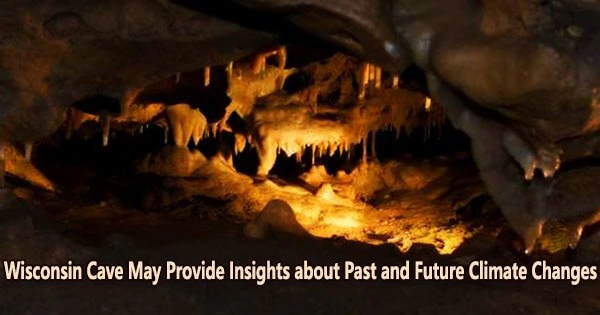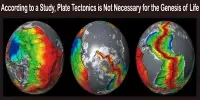Caves can store a rich record of local climate conditions and how they have changed throughout the ages, even in their gloomy seclusion from the atmosphere above. Stalagmites and stalactites, which are speleothem rock formations that are specific to caves and created over tens of thousands of years, include information about the prehistoric habitats from which they originated.
A stalagmite discovered in a cave in southern Wisconsin has been the subject of a recent study that exposes previously unknown climate history dating back thousands of years. The latest discoveries offer compelling evidence that the Northern Hemisphere was likely covered in a series of huge and sudden warming events that punctuated the most recent ice age.
The research, conducted by a team of scientists at the University of Wisconsin-Madison, appears March 2 in the journal Nature Geoscience. This is the first study to suggest a connection between temperature records from deep inside central North America and ice age warm-ups noted in the Greenland ice sheet known as Dansgaard-Oeschger episodes.
“This is the only study in this area of the world that is recording these abrupt climate events during the last glacial period,” says Cameron Batchelor, who led the analysis while completing her PhD at UW-Madison. Batchelor is now a postdoctoral fellow with the National Science Foundation working at the Massachusetts Institute of Technology.
The study is based on an incredibly thorough chemical and physical examination of a stalagmite found in the popular tourist and educational site known as the Cave of the Mounds.
“At Cave of the Mounds our mission is to interpret this geologic wonder for our many annual visitors,” says Joe Klimczak, general manager of the cave, which is a designated national natural landmark. “We are thrilled to deepen our understanding of the cave thanks to this world-class research and very exciting results.”
One theory was that the mid-continent is relatively immune to abrupt climate changes, and that maybe that’s because it’s surrounded by landmass, and there’s some type of buffering happening. However, when we went and measured, we saw these really large excursions, and we were like, ‘Oh, no, something is definitely happening.’
Cameron Batchelor
The stalagmite Batchelor and her team analyzed grew extremely slowly taking roughly 20,000 years to reach the length of a human pinky finger.
The finger-length subterranean rock formed from a complex process that began in the sky. Little fragments of limestone were dissolved along the route as water that had first fallen as precipitation from the atmosphere soaked into the ground and percolated via soil and bedrock fractures.
Then, as numerous drops of water rained from the ceiling of Cave of the Mounds, some of the dissolved limestone was left behind, gradually building up into hundreds of incredibly thin layers of a mineral known as calcite.
“And because those calcite layers are formed from that original precipitation, they’re locking in the oxygen in the H2O originating from that precipitation,” says Batchelor.
That is the secret to using a little, otherwise inconspicuous rock to rebuild an old climatic record. Scientists can use the isotopes of the oxygen that has been trapped in calcite to learn more about the environmental conditions that prevailed during the precipitation episodes that gave rise to it. This contains the temperature and potential precipitation patterns during the thousands of years that rain and snow fell on top of the Cave of the Mounds.
Using an unique imaging method, Batchelor’s team was able to recognize strata within the stalagmite that represented annual growth bands, similar to how tree rings preserve a season’s worth of growth.
Using another technique, they identified the isotopes in the tiny layers, revealing that present-day southern Wisconsin experienced a number of very large average temperature swings of up to 10oC (or about 18oF) between 48,000 and 68,000 years ago. Several of the temperature swings occurred over the course of around a decade.
While the dating information is not precise enough to definitively tie the temperature swings to the Dansgaard-Oeschger events recorded in Greenland ice cores, the researchers can say with confidence they occurred within similar timeframes.
The team’s climate simulations also supported the idea that the climate records from Cave of the Mounds and the Greenland ice sheet are really connected, and that warming events occurred in the area of North America that includes modern-day Wisconsin tens of thousands of years ago.
This probable connection excites Batchelor because it gives a previously unreported climate story about central North America. The indications of these significant temperature variations, also known as excursions, have not been clarified in earlier research from the mid-continent.
“One theory was that the mid-continent is relatively immune to abrupt climate changes, and that maybe that’s because it’s surrounded by landmass, and there’s some type of buffering happening,” says Batchelor. “However, when we went and measured, we saw these really large excursions, and we were like, ‘Oh, no, something is definitely happening.’”
Because to people and the burning of fossil fuels, the effects of a fast changing climate are once again being felt today.
Batchelor says, “she hopes her work in Wisconsin, and now a cave in the Canadian subarctic that she is studying for her postdoc, helps fill a big data gap about the history and potential future of abrupt climate changes in the mid-continent of North America.”
















